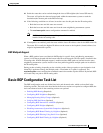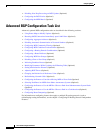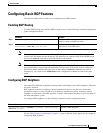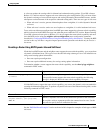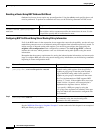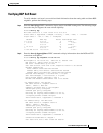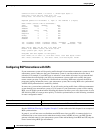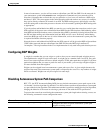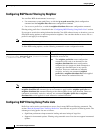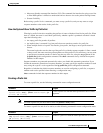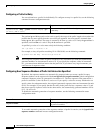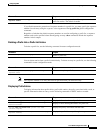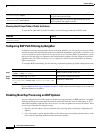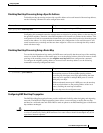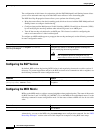
Configuring BGP
Configuring Basic BGP Features
IPC-303
Cisco IOS IP Configuration Guide
In most circumstances, you also will not want to redistribute your IGP into BGP. List the networks in
your autonomous system with network router configuration commands and your networks will be
advertised. Networks that are listed this way are referred to as local networks and have a BGP origin
attribute of “IGP.” They must appear in the main IP routing table and can have any source; for example,
they can be directly connected or learned via an IGP. The BGP routing process periodically scans the
main IP routing table to detect the presence or absence of local networks, updating the BGP routing table
as appropriate.
If you do perform redistribution into BGP, you must be very careful about the routes that can be in your
IGP, especially if the routes were redistributed from BGP into the IGP elsewhere. Redistributing routes
from BGP into the IGP elsewhere creates a situation where BGP is potentially injecting information into
the IGP and then sending such information back into BGP, and vice versa. Incorrectly redistributing
routes into BGP can result in the loss of critical information, such as the autonomous system path, that
is required for BGP to function properly.
Networks that are redistributed into BGP from the EGP protocol will be given the BGP origin attribute
“EGP.” Other networks that are redistributed into BGP will have the BGP origin attribute of
“incomplete.” The origin attribute in the Cisco implementation is only used in the path selection process.
Configuring BGP Weights
A weight is a number that you can assign to a path so that you can control the path selection process.
The administrative weight is local to the router. A weight can be a number from 0 to 65535. Any path
that a Cisco router originates will have a default weight of 32768; other paths have weight 0. If you have
particular neighbors that you want to prefer for most of your traffic, you can assign a higher weight to
all routes learned from that neighbor.
Weights can be assigned based on autonomous system path access lists. A given weight becomes the
weight of the route if the autonomous system path is accepted by the access list. Any number of weight
filters are allowed. Weights can only be assigned via route maps.
Disabling Autonomous System Path Comparison
RFC 1771, the IETF document defining BGP, does not include autonomous system path as part of the
“tie-breaker” decision algorithm. By default, Cisco IOS software considers the autonomous system path
as a part of the decision algorithm. This enhancement makes it possible to modify the decision algorithm,
bringing the behavior of the router in selecting a path more in line with the IETF specification.
To prevent the router from considering the autonomous system path length when selecting a route, use
the following command in router configuration mode:
Command Purpose
Router(config-router)# bgp bestpath as-path ignore
Configures the router to ignore autonomous system path
length in selecting a route.



